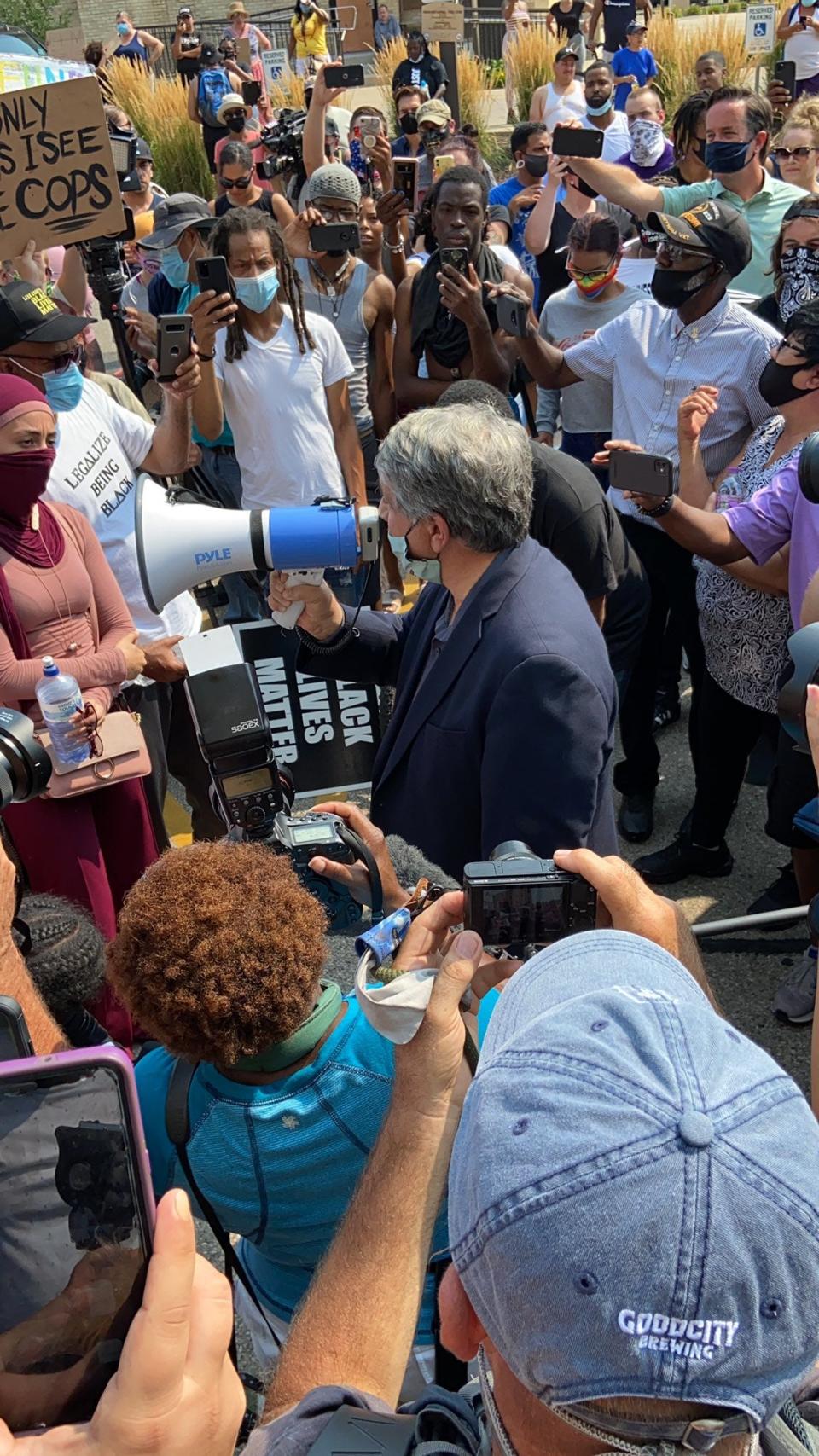'The number one priority': Kenosha mayor takes on racial inequities after Jacob Blake shooting

KENOSHA, Wis. – When John Antaramian thinks about the 20 years he has served in two stints as mayor of Kenosha, one mistake sticks out in his mind.
In 2000, Antaramian formed a committee to address what he described as several “racial issues” facing the city particularly around the quality of housing and homeownership.
“We spent about a year working on different issues. ... We actually came to some solutions on those issues,” Antaramian said. “My mistake was I didn’t keep that committee together.
"I’m refusing to make that mistake a second time. I’m getting too old to make too many mistakes.”
In short, he said, “we thought we solved the problem, and we didn’t.”
When Jacob Blake, a 29-year-old Black man was shot in the back by a white Kenosha police officer on Aug. 23, the city was thrust into the center of the nation's reckoning on race.
The violence and unrest that followed, including the case of an Illinois teen charged with killing two protesters and injuring a third, have laid bare issues Antaramian thought had been improved through the earlier effort.
A month later, the national spotlight has shifted away from Kenosha to tragedies in Portland, Oregon, Rochester, New York, and elsewhere. But local officials, activists and concerned citizens are engaging in an important conversation on how to move the city forward.
Related: Jacob Blake shooting: more details emerge
Earlier: Kenosha videos of Jacob Blake, Kyle Rittenhouse shootings prompt fierce debate over race and justice
Addressing racial issues, Antaramian said, "literally is the number one priority that we have to deal with in our community.”
Still, he notes, there is no fast solution.
“There’s nothing that we’re going to do that would automatically, ‘Oh this is taken care of. All these people are not going to be mad anymore. Everything is going to be just hunky-dory,' " he said in an interview with the Milwaukee Journal Sentinel. "This is going to be a long process.”
Listening to the people
To begin the healing process, Antaramian has launched a series of four listening sessions to allow community members to tell him and other city officials, including law enforcement, how they feel.
The first listening session on Sept. 20 was sparsely attended, but spirited.
For about an hour, attendees expressed their frustration about how the police responded to protesters and offered ideas to improve the situation. Afterward, Antaramian met one-on-one with several activists.

“It’s unfortunate the mayor isn’t a great public speaker,” said Diamond Hartwell, a Kenosha activist. “But if you sit down and calm him down and have a conversation with him, it can be a constructive conversation.”
Another Kenosha activist, Porche Bennett, said her conversation with the mayor went “shockingly” well.
“He has some good ideas, but it’s like I told him, it’s an action thing,” Bennett said. “You got to put action behind this.”
A similar sentiment was expressed by Kenosha activist Brian Little.
“It sounds like he is trying to do a little bit more,” he said. “He’s making an effort, finally. That’s all we can do is ask for that at this point in time right now.”
To help with the healing process, Antaramian has enlisted local clergy, led by Turning Point Life Church Pastor Roy Peeples, to act as bridges to the community.
“Yes, he does have his own way of understanding the issues and problems,” Peeples said. “He does have love for the community.”
Bennett is willing to give Antaramian a chance.
“For some reason, I don’t know why, I believe him,” she said. “He looks me in my eyes when he talks to me. A lot of people don’t do that and that makes me not be able to trust them when they talk to me. But he looks me in my eyes when he talks to me. So, I can give him the benefit of the doubt, for now, because, again, I want to see action.”
20 years as mayor
After he was elected in 1992, Antaramian began a focus on investing in homeownership in poorer neighborhoods.
Antaramian helped establish a program where the city would buy a vacant house and a carpenter would hire high school students to help rehab it. The money generated by the sale went back into the program, so it could expand to another house.
“The goal has always been 50% homeownership in the older neighborhoods," Antaramian said. "When you have 50% homeownership, everyone wins. The individuals who are renters start participating in the neighborhood because it’s their neighborhood and people care.”

Antaramian said a separate program from that period built that same sense of inclusion and ownership.
The Youth Employment in the Arts program helped fund public murals designed and created by young people. None were damaged during the recent unrest, he said, "because the kids did it, it was their work.”
Antaramian decided not to run in 2008, saying he felt Kenosha was in a good place. But the Great Recession hit the city hard and funding for many programs he helped create evaporated. Antaramian ran and won in 2016; he was reelected in April.
“It took me a lot of years to create the programs that we had before they went away,” he said. “It’s not going to happen tomorrow that these programs are coming back. We have to get funding sources back in place to make it happen.”
Antaramian, a Democrat, is known as a politician who can reach out to get help from Republicans. During this time of divided government in Madison, those skills will be put to the test.
“I know he cares passionately about the community he represents, and he brings a collaborative approach to benefit the city and region,” said Tommy Thompson, a former Republican governor and current University of Wisconsin System president, in a statement to the Journal Sentinel.
“He is always looking out for Kenosha," Thompson said. "There is a wealth of opportunity in this region that has had much economic success that John has been key to building.”
The city of Kenosha is strongly Democratic, while the county is much more split — it was the closest in the state in 2016, going narrowly to Donald Trump by less than 300 votes.
According to the U.S. Census Bureau, Kenosha County's population is just under 170,000, with about 75.4% white, nearly 8% Black and 13.5% Hispanic. More than half of the population, nearly 100,000, live in the city. Of that 66% are white, 11.5% are Black and 17.6% are Hispanic.
With the listening sessions ongoing, Antaramian is hesitant to say just what needs to change, but he has made clear he does not support cutting funding for police — a central aim of protesters in Kenosha and across the nation.
While there are many definitions for “defunding the police,” it generally means shifting funding from police departments to other services, such as social workers.
“We don’t have a huge amount of police, so I don’t see reducing the police budget as the solution,” Antaramian said. “What the solution is, I think, is how we spend our money smartly and what we spend it on.”
Antaramian said he wants to examine how the police can be better used in Kenosha.
“A lot of our (policing) is based off of complaints or problems, shootings, stuff like that,” he said. “We need to talk with the neighborhoods a little bit more as to how we’re doing things and what we’re doing. And it needs to be a better relationship on the basis with the police and the neighborhood.”
One group he would like to repair the relationship is with young Black men.
“We lose them in the sense that they don’t feel that there’s any hope,” Antaramian said. “There’s so many young people with huge amounts of potential, they need to become the next leaders. They need to become the individuals that are going to be the next policemen, the next firemen, the next mayor, whatever it is that they want to do.”
The wait for progress
Antaramian acknowledges it could take years for changes to really take hold.
He points to work at the old Chrysler engine plant, which used to be a mainstay employer for the city, as an example of how long change can take. He said the city has spent about $30 million in the last four years to clean up the long-vacant site so it can be redeveloped.
The aim is to build innovation centers and education facilities to help young people who live nearby.
“It will be a neighborhood focus,” Antaramian said. “That’s the process that’s already started and that’s been going on for four years I’ve been cleaning up that site.”
He also talks of improving mental health services in the city.
“We need to get a mental health facility in this town, there isn’t one in the sense of a hospital or where someone can go,” Antaramian said. “Those are the types of things we can do.”
In the short term, the Police Department will be getting funding to buy body cameras in next year's budget, a year ahead of schedule.
When the listening sessions are completed, Antaramian said he'll review what was talked about and “there may be things we can do quickly" without waiting for assistance from the state or county.
Antaramian warned that substance is required, not simply resolutions calling for action or staking positions.
“Resolutions don’t do anything,” he said. “You can (pass) all the resolutions you want ... if we’re going to do something, then we’re going to listen to people, we’re going to put together an actual plan of what we’re going to do, I’ll take that to council.”
Peeples, the Turning Point pastor, said the “window is open” to create change in Kenosha.
“We can’t go back and change the past, no man can do that, but we can work with the future in this moment, right now,” he said. “Our community was in trauma for eight years (after the Great Recession) where there was all kinds of issues and all kinds of problems that crept in.”
Follow Journal-Sentinel reporter Ricardo Torres on Twitter: @ricoreporting.
This article originally appeared on Milwaukee Journal Sentinel: Kenosha mayor takes on racial issues after Jacob Blake shooting


